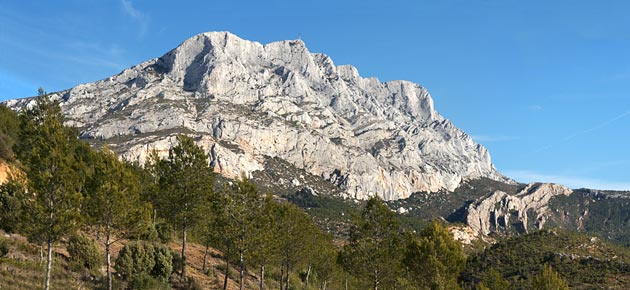Sainte-Victoire mountain
The Montagne de la Sainte-Victoire is a steep limestone ridge towering over the Aix area, its luminous white presence forming an instantly recognisable and unique landmark.
Sainte-Victoire has, for centuries, enthralled and inspired hosts of painters and writers. The most famous of these artists is Paul Cézanne, born on 19 January 1839 in Aix-en-Provence.
Entranced by its luminosity and dazzling hues of white, he captured it on canvas close on eighty times. Tragically, it was as he was painting his beloved mountain that he was taken ill and collapsed, during a violent storm, in October 1906. Carried home by labourers, he was to die of pneumonia shortly thereafter, on 22 October.
 This site is labelled "Grand site de France"
This site is labelled "Grand site de France"
Covering an area over eighteen kilometres long, the Montagne Sainte-Victoire’s highest point is the Pic des Mouches, some 1,011m above sea level, as it stretches towards the east and Aix-en-Provence. It marks the confines of the Alps and the Mediterranean region. At 942m above sea level, towering above the Vallée de l'Arc, is the Croix de Provence, a cross of 19m, high above a 17th century priory; from here, one enjoys superb views over the Provençal hills and the rolling plains of the Pays d'Aix. This is truly one of the most beautiful panoramic vistas of Provence.
In 1989, a huge fire ravaged the southern slopes of the Sainte-Victoire, destroying over 5,000 hectares. Since 1992, a great many efforts have been put into reforestation of the area, but the devastation was considerable, and the flora has been dramatically reduced, particularly where conifers are concerned. In spite of this, the Sainte-Victoire still offers beautiful woodlands of pine trees and oak trees, as well as many typically Mediterranean bushes.
Sainte-Victoire is very popular with walkers, who take great pleasure in discovering the many marked circuits, as well as with rock climbers and hang gliders.
It offers a host of riches:
Geology: a rich seam of dinosaur eggs and bones
Prehistory: remains of Celto-Ligurian settlements: Untinos and Bramefan Oppida
Roman times: ruins of the aqueduct in Le Tholonet
Worship sites dating from the 5th to the 17th century: Hermitage of Saint-Ser, Priory of Sainte-Victoire
All types of Mediterranean plants thrive on Sainte-Victoire’s southern slopes.
In the Northern foothills is the village of Vauvenargues. Its castle, a massive square building constructed between the 14th and 17th centuries, was purchased in 1958 by Pablo Ruiz Picasso, the Spanish drawer, painter and sculptor, born in Málaga on 25 October 1881. Picasso, who died on 8 April 1973, is buried in the grounds of the castle.